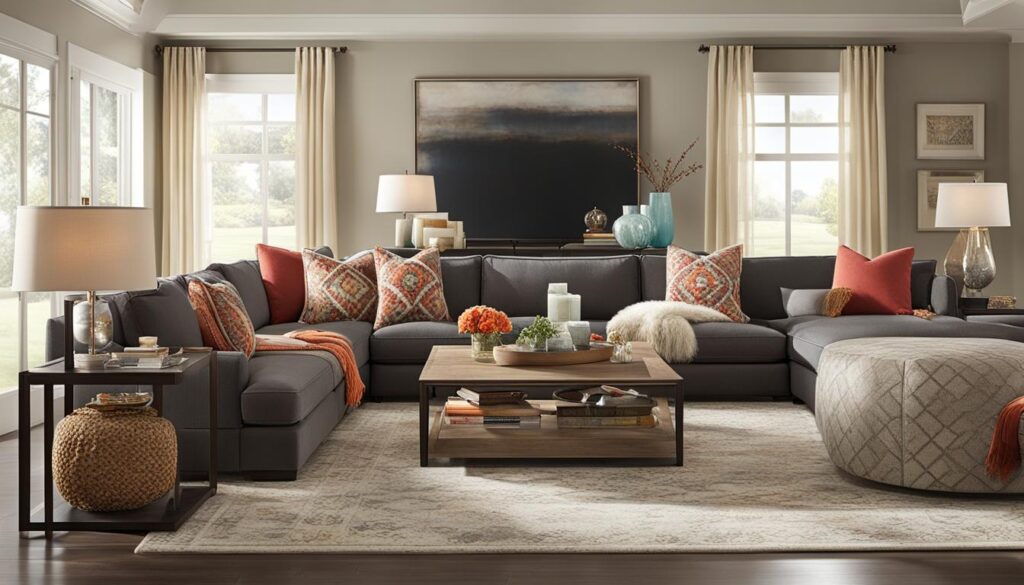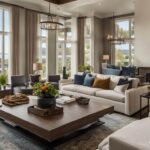When it comes to designing your living room layout, there are several factors to consider in order to create a space that is both comfortable and functional. By following these tips and ideas, you can maximize the potential of your living room and create a layout that suits your personal style and preferences.
Table of Contents
Key Takeaways:
- Consider the size and shape of your living room when arranging furniture.
- Start with the largest piece of furniture, such as a sofa, in a central position.
- Avoid blocking traffic flow and ensure each seat is within reach of a tabletop surface.
- Explore various living room layout ideas to find the one that best suits your needs and preferences.
- Experiment with different furniture configurations to create an optimal layout.
Finding the Right Furniture Arrangement for Your Living Room
Creating an effective and functional living room layout requires careful consideration of the furniture arrangement. To ensure optimal living room configuration, start by assessing the size and shape of your space, taking into account any architectural features such as fireplaces or windows. Begin by placing the largest piece of furniture, such as a sofa, in a central position to establish a focal point. From there, arrange additional seating options such as chairs or love seats to complement the main piece and create conversation areas.
When arranging furniture in a living room, it’s crucial to consider traffic flow. Ensure that each seat is within reach of a tabletop surface for convenience. Additionally, be mindful of the space between furniture pieces to maintain a comfortable and spacious atmosphere. A well-planned furniture arrangement allows for easy movement throughout the room while also promoting interaction and connectivity among guests.
Space planning for a living room involves finding the right balance between functionality and aesthetics. Experiment with different configurations to discover the layout that best suits your needs and personal style. Remember to maintain a harmonious and cohesive design by coordinating furniture pieces in terms of style, color, and scale. By carefully considering these aspects, you can create an effective living room layout that enhances both the functionality and visual appeal of the space.
“A well-planned furniture arrangement allows for easy movement throughout the room while also promoting interaction and connectivity among guests.”
Overall, the key to an effective living room layout lies in finding the optimal furniture arrangement. By considering the size and shape of your room, traffic flow, and the placement of key focal points, you can create a functional and visually appealing space. Remember to strike a balance between functionality and aesthetics, and don’t be afraid to experiment with different layout ideas until you find the perfect configuration for your living room.
| Furniture Arrangement Tips | Benefits |
|---|---|
| Start with the largest piece of furniture | Establishes a focal point and sets the tone for the room |
| Create conversation areas | Promotes interaction and connectivity among guests |
| Mindful traffic flow | Makes movement throughout the room easy and convenient |
| Consider tabletop surface accessibility | Ensures convenience for guests to place items within reach |
Different Living Room Layout Ideas to Inspire Your Design
When it comes to designing your living room layout, there is a wide array of possibilities to consider. The layout you choose should not only reflect your personal style and preferences but also enhance the functionality and flow of the space. Here are some living room layout ideas to inspire your design:
1. Formal and Balanced Layout:
For a formal and balanced layout, try placing two small sofas facing each other with a coffee table in between. This arrangement creates a cozy conversation area and is perfect for hosting guests or relaxing with a book.
2. Casual and Balanced Layout:
If you prefer a more casual and balanced layout, opt for two matching chairs and move the TV to one side of the fireplace. This arrangement creates a relaxed atmosphere and is ideal for family gatherings or movie nights.
3. Maximum Seating Options Layout:
To maximize seating options, swing the sofa lengthwise to the room and add armchairs and a pouf-as-coffee table. This layout is great for larger families or people who love to entertain, providing ample space for everyone to gather and socialize.
4. Minimal and Comfortable Layout:
If you prefer a minimalist look, keep the furniture pared down with a sectional sofa and an armchair. This layout creates a clean and uncluttered space, perfect for those who value simplicity and tranquility in their living room.
These are just a few living room layout ideas to spark your creativity. Experiment with different configurations and consider the purpose of your room to find the perfect layout that suits your needs and enhances your overall living room design.
| Layout Type | Description |
|---|---|
| Formal and Balanced Layout | Two small sofas facing each other with a coffee table in between. Ideal for creating a cozy conversation area. |
| Casual and Balanced Layout | Two matching chairs with the TV placed to one side of the fireplace. Perfect for a relaxed atmosphere. |
| Maximum Seating Options Layout | Sofa swung lengthwise to the room, accompanied by armchairs and a pouf-as-coffee table. Great for larger families or entertaining. |
| Minimal and Comfortable Layout | Pared-down furniture with a sectional sofa and an armchair. Ideal for creating a clean and uncluttered space. |
Conclusion
Designing the layout of your living room requires careful consideration of various factors and principles to create a space that is both functional and visually appealing. By following these living room layout principles, you can achieve an optimal arrangement that suits your needs and enhances the overall ambiance of the room.
One important principle to keep in mind is starting with the largest piece of furniture, such as a sofa, and positioning it in a central position. This serves as the anchor point for the rest of the layout. From there, create conversation areas by arranging additional seating options, such as chairs or love seats, in a way that promotes easy interaction among guests.
Another crucial aspect to consider is traffic flow. Ensure that there is enough space for people to move around without hindrance. Position furniture in a way that allows for smooth movement throughout the room and easy access to tabletop surfaces for placing drinks or other items.
Lastly, consider the focal point of the room. Whether it’s a fireplace, a stunning view, or a TV, arrange the furniture in a way that highlights and complements the focal point. This creates a sense of balance and harmony in the room.
Experiment with different configurations and layouts to find the perfect arrangement that suits your personal style and preferences. By keeping these living room layout principles in mind, you can create a space that not only looks aesthetically pleasing but also caters to your practical needs and enhances the overall functionality of your living room.
FAQ
What factors should I consider when designing the layout of my living room?
When designing your living room layout, consider factors such as the size and shape of the room, architectural features, and traffic flow.
Where should I start when arranging furniture in my living room?
Begin by placing the largest piece of furniture, such as a sofa, in a central position. From there, arrange additional seating options to complement the main piece.
How can I create conversation areas in my living room?
Create conversation areas by arranging seating options within reach of a tabletop surface. Ensure that each seat is positioned in a way that allows for easy conversation.
What are some different living room layout ideas I can consider?
Some living room layout ideas include formal and balanced layouts with two small sofas facing each other, casual layouts with matching chairs and a TV to one side of the fireplace, and minimal layouts with a sectional sofa and armchair.
How can I find the optimal living room layout for my needs?
Experiment with different configurations and think outside the box to find the perfect layout for your living room. Consider the purpose of the room and how you plan to use it.
Are there any principles I should follow when designing the layout of my living room?
Yes, some principles to consider include starting with the largest piece of furniture, creating conversation areas, and considering the focal point of the room.


